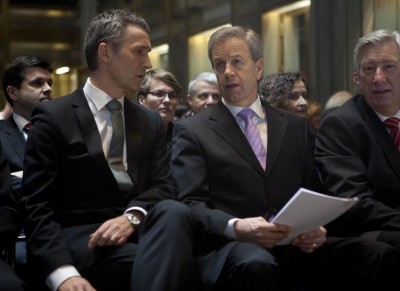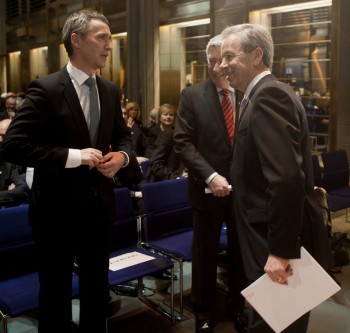A call by Norway’s central bank boss to spend less of the country’s vast oil revenues is being greeted by decidedly mixed reaction. At the very least, it looks set to spark more debate on how much should be spent or saved of the wealth pumped out of the Norwegian Continental Shelf.

Øystein Olsen, who took over as head of Norway’s central bank (Norges Bank) last year, delivered his second annual address (external link) to the country’s political and business elite on Thursday. The bank boss’ talk is always a lengthy and comprehensive assessment of the global and Norwegian economy, and a key portion of Olsen’s address attracted the most attention: He believes the Norwegian government should cut the amount of oil revenues that are pumped into the state budget, since the fund where oil revenues are saved isn’t generating the returns that are expected.
Instead of using 4 percent of the amount currently stashed away in Norway’s sovereign wealth fund, also known as the oil fund, Olsen thinks Norwegian politicians should only allow 3 percent to be used. The current 4 percent annual allowance, called handlingsregelen in Norwegian, is based on what was believed to be the average annual return generated by the fund, which long has ranked as one of the largest sovereign wealth funds in the world. It was set up by the Norwegian government in the 1990s as a means of saving the country’s oil wealth for future generations, and it functions as a pension fund.

The fund’s returns, though, have been hit by the global finance and euro crises, and Olsen said they’ve averaged 2.5 percent since 1998. “If we spend more than the annual return on the fund, we will be eating into the savings portion,” Olsen said, arguing that such spending can threaten its sustainability.
Olsen’s proposal could mean a 25 percent reduction in the amount of oil money that’s allowed to be spent. Newspaper Aftenposten equated that to around NOK 35 billion (nearly USD 6 billion), the size of an entire annual budget for the Defense Ministry.
Given the need for improvements to everything from schools to transport to health and elder care in Norway, such restrictions on the use of the country’s oil wealth are not popular. The Progress Party, Norway’s most conservative party, has long argued for more use of Norway’s oil wealth – a paradox, perhaps, since conservative parties generally advocate less government spending, not more, and often bashed as populistic.
Norway’s Conservative Party itself seemed more open to Olsen’s call for cuts in withdrawals from the oil fund. Erna Solberg, leader of the Conservatives and a candidate for prime minister, told Norwegian Broadcasting (NRK) that she was unsure whether Olsen is correct in suggesting that the 4 percent rule should be changed, but praised him for “raising an important debate. The oil money we have shall create security for future generations and retirees.”
Several economists backed Olsen’s proposal as did newspaper Aftenposten, which editorialized on Friday that Olsen’s proposal should be supported because it’s “reasonable” and “not nearly as drastic as it sounds.” That’s because Norway’s strong economy is generating record levels of tax revenues for the state treasury. Actual use of oil money this year, according to state statistics bureau SSB, may only amount to 2 percent of the size of the oil fund.
Finance Minister Sigbjørn Johnsen of the Labour Party is already being careful about tapping into the oil fund, and doesn’t think the actual 4 percent handlingsregel (annual allowance) needs to be changed. Nor does Prime Minister Jens Stoltenberg, who leads a coalition government that still has a majority in parliament.
The current 4 percent rule “has served the Norwegian economy very well for many years,” Stoltenberg told NRK. “Responsible, long-term use of our oil money is a main reason why we have Europe’s lowest unemployment and good growth in the Norwegian economy, and that we also have money to invest in (such areas as) knowledge, research and transportation.”
His fellow coalition leaders from the Center Party and Socialist Left party agreed. Changing the rule based on the recent economic downturn would, they argue, would be a reaction that’s too “short-term in perspective.”
Olsen’s proposal thus looks unlikely to be enacted. Debate over use of oil revenues, though, is more than likely to continue.
Views and News from Norway/Nina Berglund
Please support our stories by clicking on the “Donate” button now:

